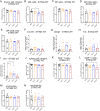Tissue inflammation induced by constitutively active STING is mediated by enhanced TNF signaling
- PMID: 40111902
- PMCID: PMC11996172
- DOI: 10.7554/eLife.101350
Tissue inflammation induced by constitutively active STING is mediated by enhanced TNF signaling
Abstract
Constitutive activation of STING by gain-of-function mutations triggers manifestation of the systemic autoinflammatory disease STING-associated vasculopathy with onset in infancy (SAVI). In order to investigate the role of signaling by tumor necrosis factor (TNF) in SAVI, we used genetic inactivation of TNF receptors 1 and 2 in murine SAVI, which is characterized by T cell lymphopenia, inflammatory lung disease, and neurodegeneration. Genetic inactivation of TNFR1 and TNFR2, however, rescued the loss of thymocytes, reduced interstitial lung disease, and neurodegeneration. Furthermore, genetic inactivation of TNFR1 and TNFR2 blunted transcription of cytokines, chemokines, and adhesions proteins, which result from chronic STING activation in SAVI mice. In addition, increased transendothelial migration of neutrophils was ameliorated. Taken together, our results demonstrate a pivotal role of TNFR signaling in the pathogenesis of SAVI in mice and suggest that available TNFR antagonists could ameliorate SAVI in patients.
Keywords: SAVI; STING; TNF; immunology; inflammation; mouse; systemic autoinflammation; vasculopathy.
© 2025, Luksch et al.
Conflict of interest statement
HL, FS, DG, DS, LH, ES, WT, SW, CG, AL, RB, LT, BF, AR No competing interests declared
Figures










Update of
- doi: 10.1101/2024.04.25.591149
References
-
- Balka KR, Louis C, Saunders TL, Smith AM, Calleja DJ, D’Silva DB, Moghaddas F, Tailler M, Lawlor KE, Zhan Y, Burns CJ, Wicks IP, Miner JJ, Kile BT, Masters SL, De Nardo D. TBK1 and IKKε act redundantly to mediate STING-Induced NF-κB responses in myeloid cells. Cell Reports. 2020;31:107492. doi: 10.1016/j.celrep.2020.03.056. - DOI - PubMed
-
- Belhacéne N, Gamas P, Gonçalvès D, Jacquin M, Beneteau M, Jacquel A, Colosetti P, Ricci JE, Wakkach A, Auberger P, Marchetti S. Severe thymic atrophy in a mouse model of skin inflammation accounts for impaired TNFR1 signaling. PLOS ONE. 2012;7:e47321. doi: 10.1371/journal.pone.0047321. - DOI - PMC - PubMed
MeSH terms
Substances
Associated data
- Actions
Grants and funding
LinkOut - more resources
Full Text Sources
Research Materials

